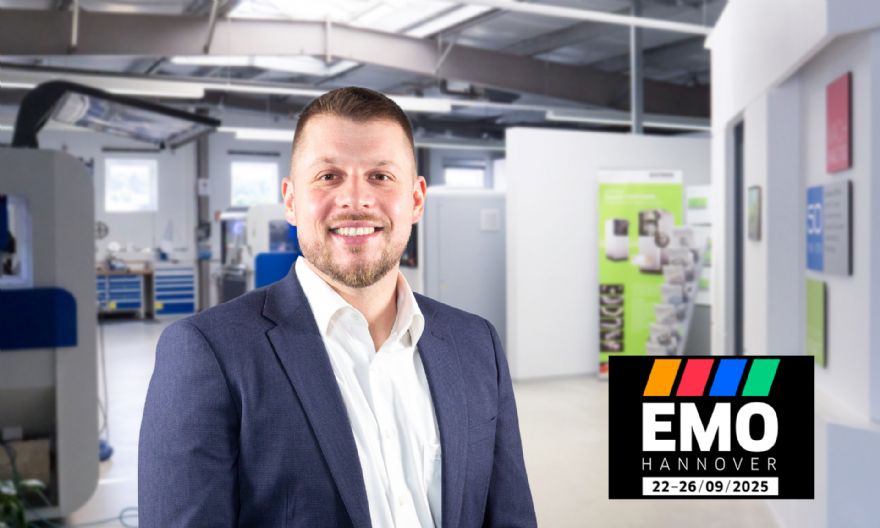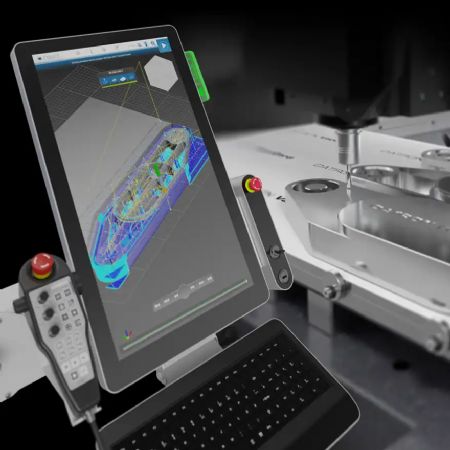 Jonas Gillmann, chief technology officer at Datron. Photo: Datron AG
Jonas Gillmann, chief technology officer at Datron. Photo: Datron AGIndustrial manufacturing is currently undergoing a seismic change. Artificial intelligence (AI) is finding its way into machine tools and is not only changing production processes, but also the maintenance of machines — it is establishing itself as the control centre for efficient, sustainable and competitive production.
In times of skills shortages and international competitive pressure, it is far more than just a technological sideshow — it is becoming a survival strategy. At
EMO Hannover 2025, the world's leading trade fair for production technology, which is taking place from 22 to 26 September, visitors will be able to see first-hand how AI is revolutionising industrial production. AI in machine tools means much more than just automation — it enables machines to learn from data, make decisions and optimise processes. Sensor technology, data analysis, machine learning and intelligent assistance systems are all harnessed for this purpose, both at the control level and in interaction with the operator.
There are many possible applications for manufacturing companies. Professor Philipp Klimant, head of the business unit for process digitisation and manufacturing automation at the
Fraunhofer Institute for Machine Tools and Forming Technology (IWU) in Chemnitz, said: “Typical examples would be the prediction of process properties in real-time operation for inline quality control and the monitoring of processes and their properties. The advantage over traditional approaches is the ability to include a particularly large number of parameters in the monitoring process.”

However, there are also numerous other fields of application, such as AI assistance models for training and AI to support maintenance. The Fraunhofer IWU, which specialises in the production-related adaptations of traditional and modern machine learning methods, is headed by the trio of Martin Dix, Welf-Guntram Drossel and Steffen Ihlenfeldt. All three are members of the
WGP (Wissenschaftliche Gesellschaft für Produktionstechnik/German Academic Association for Production Technology), an association of leading German professors in the field of production science.
As of January, the WGP has consolidated the ProKI initiative, which was originally funded by the The Federal Ministry of Education and Research (BMBF), under its umbrella and has since been offering highly practical expertise and demonstrators, especially to small and medium-size companies that want to find out about the potential of AI for their businesses or are looking for support.
The IWU researcher’s tip is to ask the following question at the very beginning: how large are the efficiency gains that are actually possible through AI in my production process? Professor Klimant said: “The question of what efficiency gains are possible cannot be answered universally without further analysis.” The potential is heavily dependent on the actual process and the associated optimisation possibilities.
Efficiency gains with AIHe continued: “In the field of plastics processing, injection moulding for example, reject rates of 20 to 30% can occur in rare cases.” This represents a major lever for efficiency gains with AI. It can also be useful for processes that are already running with a high level of stability, for example in the area of predictive maintenance and to achieve longer service lives of tools.
 Pictured left: Professor Philipp Klimant. Photo: Fraunhofer IWU
Pictured left: Professor Philipp Klimant. Photo: Fraunhofer IWUAccording to Professor Klimant, AI can also make an important contribution to alleviating the shortage of skilled workers. The scientist, who has also been Professor of Virtual Technologies at
Mittweida University of Applied Sciences in Saxony since 2023, explained: “We store knowledge implicitly in AI. This knowledge can be used to train new employees, especially when older colleagues retire and important knowledge leaves the company. This repository of AI knowledge also offers new opportunities for automation, not least for automated quality control.”
Professor Klimant explained: “When we talk about AI, we usually mean machine learning as a sub group of AI. This is able to learn independently from training data. It is an empirical process that learns correlations without us knowing the analytical correlations. Simply put, we learn from experience.” AI is used to optimise the process parameters in production and feed them back into the process controller via an automated control system.
He added: “AI is like a black box, input values go in and forecasts come out. One example of this would be a forming process where we measure an acoustic signal and then the AI tells us whether or not the process was successful.”
Ultimately, it is a digital system that can be connected to control systems via existing interfaces. This allows AI to influence control algorithms at various points. However, in order for AI to be used successfully in production, hardware with very high computing power is more ofte than not required.
Computationally intensiveProfessor Klimant continued: “First of all, a distinction must be made between the training phase and the utilisation phase (inference). The training phase is always more computationally intensive, but is carried out offline. In the utilisation phase, edge devices are often sufficient for classic methods such as the support vector machine.”
The situation is different when it comes to the topic of image processing. These AI models require more computing power, both in the training phase and in the utilisation phase. “The application cycle also plays a decisive role here. If I need a result every 5sec, for example, I will need more computing power compared to a cycle time of 30sec.” The evaluation of language models represents an exception here. These require powerful hardware, from high-performance consumer graphics cards through to special AI cards.
Self-learning machine tools are made possible by AI. For example, milling machine manufacturer and
EMO exhibitor
Datron AG from Ober-Ramstadt near Darmstadt makes use of this innovation, in which the machine draws on learned knowledge and adapts the production process. The aim is to develop Datron milling machines into adaptive production cells that automatically adjust to component requirements and environmental conditions.
Jonas Gillmann, Datron’s chief technology officer, said: “This not only reduces set-up and machining times, but also increases process stability — a decisive step towards autonomous production.”
AI is thus shifting the focus away from rigid programming towards assisted, self-learning and adaptive production. Mr Gillmann continued: “Machines are becoming partners in the manufacturing process, which adapt to humans — not the other way around. In mechanical engineering, this is no longer a vision, but is increasingly becoming a reality.”
As he explained, AI in production offers high levels of efficiency gains: “In CNC production with Datron machines, it can reduce set-up times by up to 60%, significantly reduce the amount of rejects and extend the service life of tools — while at the same time increasing process reliability.
Mr Gillmann, who started his career as an industrial mechatronics technician at the milling machine manufacturer, said one particularly exciting advance is the link with the ‘Datron next’ control software. This guides even inexperienced operators intuitively through the milling process and automatically recognises workpieces.
“This means that even employees who are not specialised in the technology can perform milling productively — a clear advantage in view of the shortage of skilled workers.” AI will in future also allow predictive maintenance to be carried out in order to prevent failures before they occur. “This will make the milling process more efficient, more robust and more flexible in terms of the personnel required.”
AI in machine tools can also help to meet the increasing demand for customer-specific products in small quantities. Mr Gillmann said: “AI makes the production of small batch sizes economical — with the Datron next control software, workpieces are recognised automatically — without complex programming. This eliminates the need for long set-up times, and individual parts can also be manufactured quickly, efficiently and to a high level of quality, which is ideal for customised products.”
Self-learning machine tools are also changing the job description of the user. Mr Gillmann added: “Less programming, more process responsibility.” Employees are becoming process designers who ensure quality and optimise processes. He concluded: “This lowers the barrier to entry and human expertise is supplemented – not replaced – by smart assistance.”